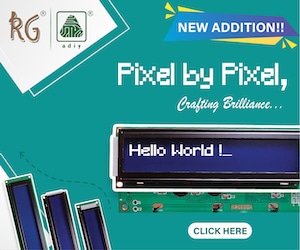Wireless charging is no more inferior to wired charging. Better standards, integration methods, and components have evolved over the past few years to make wireless charging a better technology. And it need not be confined to charging cell phones. Find out how?
The multimedia-rich portable electronic devices available now end up consuming a lot of energy just to keep the device’s graphics processing unit juiced up. Let us take a cell phone for instance. The traditional approach is to look for a wall socket and push in the wired charger’s plug to charge the battery.
Though a cell phone can also be charged wirelessly, most people are wary of the time it takes to charge the phone wirelessly. No one wants to wait for hours to charge a phone’s battery wirelessly, especially when you need to use the device in next 15-20 minutes. But does wireless charging still take a long time to power up a device?
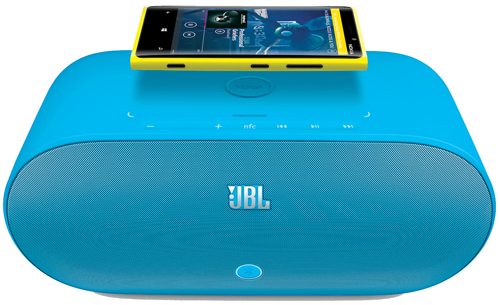
Although called wireless, wireless charging is not totally without wires. The primary coil in the charger needs current from AC mains to produce magnetic flux, which produces current in the charger’s secondary coil by induction for charging the device. So the primary coil is plugged into an AC socket using wires, though called wireless. Wireless charging, when started, was based on Qi inductive power standard that was produced in 2008 by WPC (Wireless Power Consortium).
The low-power Qi specification limits the draw of power to just 0W to 5W, which limits the current available to the device for charging. But newer wireless chargers available in the market are much better and can transmit a higher amount of current. A few years ago, Qi began to extend its specification to medium power to deliver up to 120 watts.
Chips like Broadcom’s BCM59350 let gadgets use any wireless charging standard. What’s more, it is not strangled by the previous 5W limit and can go up to 50% higher levels without breaking sweat. This results in a charging speed that can finally compete with what your travel charger gives you through its wire. Modern wireless charging allows the transfer of upwards of 1A current.
Wireless Charging Advantages
Here are some features and advantages that wireless charging offers-
Resonance Charging
The new wireless charging standard A4WP (Alliance for Wireless Power) is changing the concept of inductive charging from magnetic induction to resonance. Magnetic induction requires the two coils to be placed very closely, whereas with this technique a large area is covered so the device’s position is not very critical.
In fact, multiple devices can be charged wirelessly with this technique by placing them all within the wide resonant field. And charging is not affected by the position of the device being charged. No matter how you position the device on the charging pad, the maximum amount of power gets transferred to the device to charge it easily and fast.
The chargers based on A4WP standard transfer power wirelessly at a frequency of 6.78 MHz, which is internationally available for such applications. The frequency used for control and management is within the 2.4GHz band, which is ideal for use with smartphones and with other electronics devices globally.
Itay Sherman, CTO, Power Matter Alliance says, “Although both inductive and resonant charging are based on the same principle, the main difference between the two is the coupling factor. It defines how the two coils will be aligned to transfer maximum flux. When measured on a scale 0 means less coupling factor and 1.0 means high coupling factor. Devices based on inductive charging technology have a coupling factor of 0.3 to 0.8 whereas devices based on resonance charging can also have a coupling factor below 0.3.”
Charger-receiver Alignment
Quick and proficient charging is possible only when the primary coil (transmitter) identifies the secondary (receiver). If the transmitter works efficiently but the receiver does not, the wireless charger loses its significance.
Texas Instruments has recently come up with two 5W receivers (bq51020 and bq51021) focussed around the Qi 1.1 standard. They offer a programmable yield voltage of about 8V, reducing the power loss and the rise in temperature by 35% compared to other charging solutions. The I²C interface in bq51201 enables designers to implement the pad detection feature, an easy way to align the receiver with the charger, and foreign object detection to allow faster and more efficient charging of all Qi-compliant gadgets.
Lesser Components
Texas Instruments also came up with bq500412 which allows designers to develop charging stations with half the number of components used in other charging solutions. This transmitter, featured on foreign object detection though created for a 12V charging pad, can also be used with a boost converter to create a 5V USB charging pad with three coils to limit power loss.

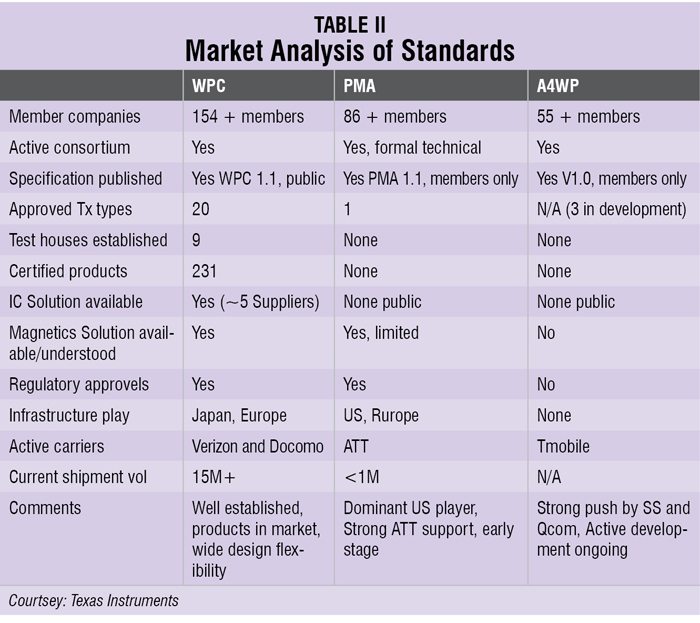
PowerbyProxi brings a fully integrated receiver circuit that fits easily into a smartphone to charge its battery wirelessly. You can place at least three devices on its pad for simultaneous charging. It charges a device at the speed of a wired charger without overheating its components.
Comforting Power
Charging has moved on from what has hitherto been a utility to one that comes with an aura of comfort. Though the modules integrated in furniture are based on Qi technology they can also charge the devices that are not based on Qi technology. To accomplish this they use an adaptor with the module. C+P Furniture Systems is working to bring the whole new Cegano smart table and Prefino locker system with the wireless charging facility for smartphones.
Leggett & Platt have developed Helios, an inductive charging system available in puck shapes or low-profile designs. It is an intelligent system that communicates with the device to be charged. That is, the primary coil communicates with the secondary to identify its power requirements and charges it accordingly. Once Helios identifies that the device is fully charged, it cuts off charging and turns on the LED indicating full charge. Although the device is charged wirelessly, Helios has to be plugged into a socket to power the primary coil.

“Wireless charging furniture tables, chairs, and desks—is not very far. In fact, many of us (including Knewron) are already in the design phase of these things. However, these are not out-of-the-box solutions either; just being manifestations and augmentations of existing technology with surroundings. Either way, it will soon be ready to jolt the interior decoration and furniture market,” explains T. Anand, Knewron.
New Wireless Charging Standards
Alliance for Wireless Power (A4WP) is a wireless charging standard that came up recently. Although the products based on Qi and Power Matter Alliance (PMA) standards are already in the market, the products based on A4WP are yet to be seen.
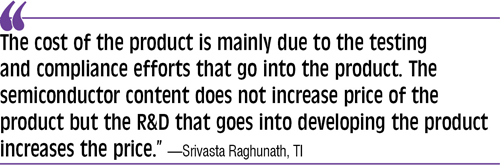
Verizon and DOCOMO are using the Qi standard, AT&T has chosen the PMA standard and T-Mobile wants to use A4WP. Power Matters brings various PMA-based wireless charging options like a Power snap kit, travel mat, power mat, and access kit for high-end mobile devices.
Anand says, “While there are adequate tools and resources available from various chip manufacturers for designing the wireless charging devices, on-going battle and unstable standards are restrictive. It is difficult for the designers to neglect one or two particular standards that in turn would add to the cost of product and design activity. Having said that, it is still less of a design problem and more of an innovative utilization problem for the majority of us.”
On the contrary, Srivasta Raghunath, technical lead – Analog Systems, Texas Instruments restricts himself to the new standards. He says, “Since A4WP is still evolving, there has been no standardization and no particular tools developed yet. This is still in the R&D stages and will be evolving in the coming years.”
Future
Although the main focus of wireless charging has been small portable devices, it cannot be limited to these devices alone. The main aim of this type of charging technology is to transfer maximum power to the receiver in a wire-free environment.
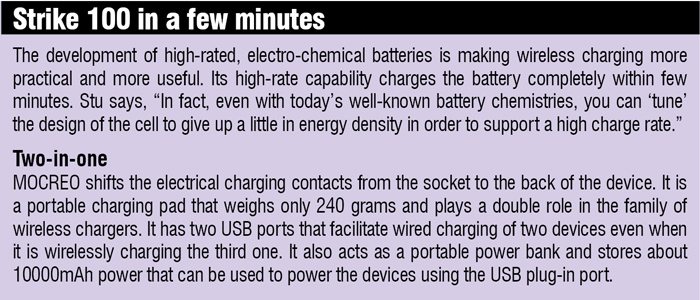
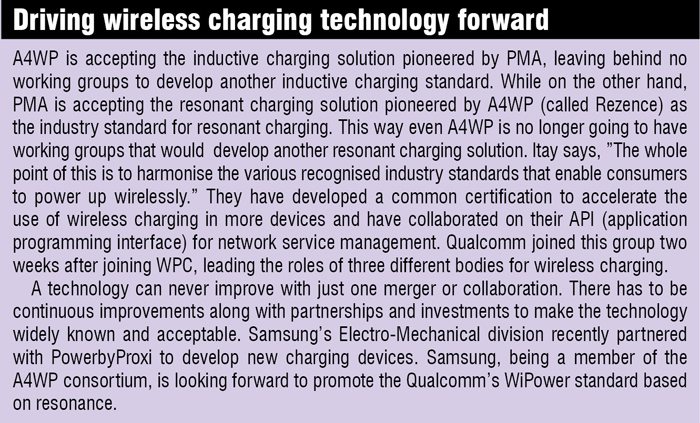
All electric transport buses that have been introduced on a trial basis, on the streets of Milton in UK for five years, use wireless charging technology on a larger scale. Although the buses are completely charged at night, they need top-up charges after every route. The buses receive the top-up charges from the top-up stations that appear as plates on the road.
After completing one route, the bus is parked on that plate where the driver lowers the receiver plate from the bottom of the bus to 4 cm below the road surface. The bus is charged only for ten minutes before starting on the next route. It follows the same magnetic flux technology for wireless charging. Though these buses are currently being used on a trial basis, it is not long before wireless charging will come to the mainstream.
Also Read: Wireless Charging is the Fuel of Future
“We envision a world in which wireless charging would accelerate the adoption of clean, green electrified vehicles,” says WiTricity CEO Eric Giler in one of the reports. With Toyota deciding to license intellectual property from WiTricity to offer wireless charging on both hybrid-electric and fully-electric vehicles, Eric adds, “To have Toyota, the world’s leading carmaker, licensing our intellectual property, underscores the importance of the technology.”
In future, we will not only see the extensive use of wireless charging technology but also see some enhancements in the standards enabling this technology. Although Qi is typically an inductive charging technology, WPC is developing a resonance extension to its specifications. Resonant extension to Qi is expected to be backward compatible with more than 40 million products and devices globally, including the 60 models of Qi-compatible devices. In one of the reports, John Perzow, vice president of Market Development for the Wireless Power Consortium said that Qi is constantly enhancing to give away the best wireless charging experience.
Stu Lipoff, IEEE fellow, said, “One vision is to have NFC RFID in the phone that provides the local power company with billing information so that they can charge your credit card for power purchased as you walk by the public outdoor wireless charging infrastructure.” He added, “With the development of extended distance wireless charging, it even becomes possible to charge the devices by walking outside on the street in proximity to public portable power infrastructure.”
Itay says, “PMA is already working to globalize this wireless charging by integrating more technologies at the physical layer. We are working on providing networking standards and deploying public hotspots for wireless charging.”
The author is a technical journalist at EFY


